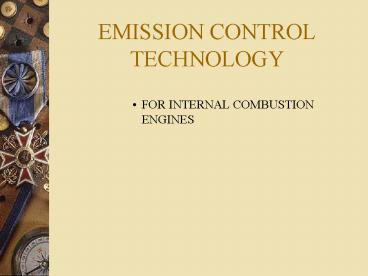EMISSION CONTROL TECHNOLOGY - PowerPoint PPT Presentation
1 / 17
Title:
EMISSION CONTROL TECHNOLOGY
Description:
... coated with a metal catalyst, usually platinum, rhodium and/or palladium. ... monoxide by burning (oxidizing) them over a platinum and palladium catalyst. ... – PowerPoint PPT presentation
Number of Views:3612
Avg rating:5.0/5.0
Title: EMISSION CONTROL TECHNOLOGY
1
EMISSION CONTROL TECHNOLOGY
- FOR INTERNAL COMBUSTION ENGINES
2
INTRODUCTION
- INTERNAL COMBUSTION ENGINES ARE USED IN A VARIETY
OF STATIONARY APPLICATIONS RANGING FROM POWER
GENERATION TO INERT GAS PRODUCTION. - BOTH SPARK AND COMP. ENGINES CAN BE FOUND.
- A VARIETY OF FUELS CAN BE USED FOR I.C.ENGINES.
- THE OPERATION OF I.C ENGINES RESULTS IN THE
ENISSION OF HYDROCARBONS,CO,NOX,, PARTICULATE
MATTER.
3
TECHNIQUES USED TO CONTROL
- CATALYST CONTROL TECHNOLOGY-
- PRINCIPLE- USED FOR CONTROLLING THE GASEOUS
EMISSION OF A STATIONARY I.C. ENGINES THE
CATALYST CAUSES CHEMICAL REACTIONS WITHOUT BEING
CHANGED OR CONSUMED. CATALYST TRANSFORM
POLLUTANTS INTO HARMLESS GASES.
4
SELECTIVE CATALYTIC REDUCTION
- INTRODUCING A REDUCING AGENTS SUCH AS
AMMONIA,UREA,MAKES THE NECESSARY CHEMICAL
REACTIONS POSSIBLE. - THE REACTIONS ARE-
- 4NO4NH3O2--? 4N26H2O
- 2NO4NH32O2--? 3N26H2O
5
OXIDATION CATALYSTS
- OXIDATION CATALYSTS CONTAIN PRECIOUS METALS
IMPREGNATED INTO A HIGH GEOMATRIC SURFACE AREA
CARRIER AND ARE PLACED IN THE EXHAUST STREAM THEY
ARE VERY EFFECTIVE IN CONTROLLING COHYDROCARBON
EMISSION.
6
CATALYTIC CONVERTER
7
WORKING
- HELP IN REDUCING EMISSIONS
- BY CONTROLLING EXHAUST BEFORE IT LEAVES THE
ENGINE. - BY CONTROLLING THE AIR TO FUEL RATIO(IDEAL RATIO
14.71 )
8
HOW REDUCE POLLUTION
- Most modern cars are equipped with three-way
catalytic converters. "Three-way" refers to the
three regulated emissions it helps to reduce --
carbon monoxide, VOCs and NOx molecules. The
converter uses two different types of catalysts,
a reduction catalyst and an oxidation catalyst.
Both types consist of a ceramic structure coated
with a metal catalyst, usually platinum, rhodium
and/or palladium. The idea is to create a
structure that exposes the maximum surface area
of catalyst to the exhaust stream, while also
minimizing the amount of catalyst required (they
are very expensive).
9
DIAGRAMS
10
(No Transcript)
11
TYPES
- There are two main types of structures used in
catalytic converters -- honeycomb and ceramic
beads. Most cars today use a honeycomb structure.
12
(No Transcript)
13
TYPE 1
- The Reduction CatalystThe reduction catalyst is
the first stage of the catalytic converter. It
uses platinum and rhodium to help reduce the NOx
emissions. When an NO or NO2 molecule contacts
the catalyst, the catalyst rips the nitrogen atom
out of the molecule and holds on to it, freeing
the oxygen in the form of O2. The nitrogen atoms
bond with other nitrogen atoms that are also
stuck to the catalyst, forming N2. For example - 2NO gt N2 O2 or 2NO2 gt N2 2O2
14
TYPE2
- The Oxidization CatalystThe oxidation catalyst
is the second stage of the catalytic converter.
It reduces the unburned hydrocarbons and carbon
monoxide by burning (oxidizing) them over a
platinum and palladium catalyst. This catalyst
aids the reaction of the CO and hydrocarbons with
the remaining oxygen in the exhaust gas. For
example - 2CO O2 gt 2CO2
15
(No Transcript)
16
CONTROL SYSTEM
- The third stage is a control system that monitors
the exhaust stream, and uses this information to
control the fuel injection system. There is an
oxygen sensor mounted upstream of the catalytic
converter, meaning it is closer to the engine
than the converter is. This sensor tells the
engine computer how much oxygen is in the
exhaust. The engine computer can increase or
decrease the amount of oxygen in the exhaust by
adjusting the air-to-fuel ratio. This control
scheme allows the engine computer to make sure
that the engine is running at close to the
stoichiometric point, and also to make sure that
there is enough oxygen in the exhaust to allow
the oxidization catalyst to burn the unburned
hydrocarbons and CO.
17
THANKS































